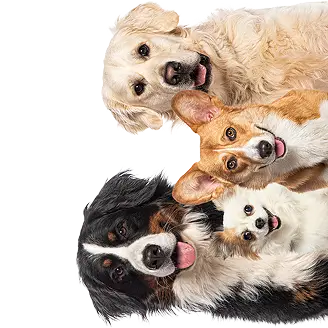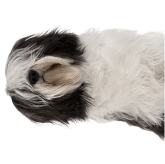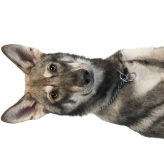Dog breeds
Wamiz has put together a detailed list of dog breeds recognised by the FCI and the Kennel Club. The Federation Cynologique Internationale has categorised each of these breeds into 7 different types: Gun dog, toy dog, utility dog, hound dog, terrier, working dog and pastoral. A complete list of over 300 breeds with their respective pictures and a full description of their features, personality, health issues, origins and much more. This guide is here to help you understand which dog is best suited for you, based on their needs and personality.
176 dog breeds
-
 Afghan Hound
Afghan Hound
-
 Airedale Terrier
Airedale Terrier
-
 Akita Inu
Akita Inu
-
 Alpine Dachsbracke
Alpine Dachsbracke
-
 American Akita
American Akita
-
 American Cocker Spaniel
American Cocker Spaniel
-
 American Foxhound
American Foxhound
-
 American Staffordshire Terrier
American Staffordshire Terrier
-
 Anatolian Shepherd
Anatolian Shepherd
-
 Ariege Pointing Dog
Ariege Pointing Dog
-
 Australian Cattle Dog
Australian Cattle Dog
-
 Australian Kelpie
Australian Kelpie
-
 Australian Shepherd
Australian Shepherd
-
 Australian Terrier
Australian Terrier
-
 Austrian Black and Tan Hound
Austrian Black and Tan Hound
-
 Austrian Pinscher
Austrian Pinscher
-
 Basenji
Basenji
-
 Basset Fauve de Bretagne
Basset Fauve de Bretagne
-
 Basset Hound
Basset Hound
-
 Bavarian Mountain Scent Hound
Bavarian Mountain Scent Hound
-
 Bearded Collie
Bearded Collie
-
 Black and Tan Coonhound
Black and Tan Coonhound
-
 Bloodhound
Bloodhound
-
 Boerboel
Boerboel
-
 Border Terrier
Border Terrier
-
 Borzoï
Borzoï
-
 Bouvier des Ardennes
Bouvier des Ardennes
-
 Briquet Griffon Vendeen
Briquet Griffon Vendeen
-
 Broholmer
Broholmer
-
 Bullmastiff
Bullmastiff
-
 Cairn Terrier
Cairn Terrier
-
 Canaan Dog
Canaan Dog
-
 Canarian Warren Hound
Canarian Warren Hound
-
 Catalan Sheepdog
Catalan Sheepdog
-
 Caucasian Shepherd Dog
Caucasian Shepherd Dog
-
 Cavachon
Cavachon
-
 Cavalier King Charles Spaniel
Cavalier King Charles Spaniel
-
 Central Asia Shepherd Dog
Central Asia Shepherd Dog
-
 Chihuahua
Chihuahua
-
 Chinese Crested Dog
Chinese Crested Dog
-
 Chinook
Chinook
-
 Chiweenie
Chiweenie
-
 Chow Chow
Chow Chow
-
 Cirneco Dell'Etna
Cirneco Dell'Etna
-
 Coarse-haired Styrian Hound
Coarse-haired Styrian Hound
-
 Cocker Spaniel
Cocker Spaniel
-
 Dachshund
Dachshund
-
 Deerhound
Deerhound
-
 Drever
Drever
-
 Dutch Schapendoes
Dutch Schapendoes
-
 Dutch Shepherd
Dutch Shepherd
-
 East Siberian Laika
East Siberian Laika
-
 English Foxhound
English Foxhound
-
 English Toy Terrier (Black & Tan)
English Toy Terrier (Black & Tan)
-
 Entlebuch Cattle Dog
Entlebuch Cattle Dog
-
 Eurasier
Eurasier
-
 Fawn Brittany Griffon
Fawn Brittany Griffon
-
 Finnish Hound
Finnish Hound
-
 Finnish Lapponian Dog
Finnish Lapponian Dog
-
 Finnish Spitz
Finnish Spitz
-
 French Pointing Dog
French Pointing Dog
-
 French Tricolour Hound
French Tricolour Hound
-
 French White & Orange Hound
French White & Orange Hound
-
 Gascon Saintongeois
Gascon Saintongeois
-
 German Hound
German Hound
-
 German Shepherd
German Shepherd
-
 Golden Cocker Retriever
Golden Cocker Retriever
-
 Gordon Setter
Gordon Setter
-
 Grand Griffon Vendeen
Grand Griffon Vendeen
-
 Great Anglo-French Tricolour Hound
Great Anglo-French Tricolour Hound
-
 Great Anglo-French White & Orange Hound
Great Anglo-French White & Orange Hound
-
 Great Dane
Great Dane
-
 Great Swiss Mountain Dog
Great Swiss Mountain Dog
-
 Greek Harehound
Greek Harehound
-
 Greenland Dog
Greenland Dog
-
 Greyhound
Greyhound
-
 Griffon Belge
Griffon Belge
-
 Griffon Bruxellois
Griffon Bruxellois
-
 Hanoverian Scent Hound
Hanoverian Scent Hound
-
 Harrier
Harrier
-
 Hokkaido
Hokkaido
-
 Hovawart
Hovawart
-
 Hungarian Greyhound
Hungarian Greyhound
-
 Hungarian Hound - Transylvanian Scent Hound
Hungarian Hound - Transylvanian Scent Hound
-
 Hygen Hound
Hygen Hound
-
 Ibizan Podenco
Ibizan Podenco
-
 Icelandic Sheepdog
Icelandic Sheepdog
-
 Irish Doodle
Irish Doodle
-
 Irish Glen of Imaal Terrier
Irish Glen of Imaal Terrier
-
 Irish Red and White Setter
Irish Red and White Setter
-
 Irish Red Setter
Irish Red Setter
-
 Irish Soft-coated Wheaten Terrier
Irish Soft-coated Wheaten Terrier
-
 Irish Terrier
Irish Terrier
-
 Irish Wolfhound
Irish Wolfhound
-
 Italian Segugio
Italian Segugio
-
 Italian Volpino
Italian Volpino
-
 Japanese Chin
Japanese Chin
-
 Japanese Terrier
Japanese Terrier
-
 Kai Ken
Kai Ken
-
 King Charles Spaniel
King Charles Spaniel
-
 Kishu
Kishu
-
 Korea Jindo Dog
Korea Jindo Dog
-
 Labradoodle
Labradoodle
-
 Lakeland Terrier
Lakeland Terrier
-
 Lancashire Heeler
Lancashire Heeler
-
 Little Lion Dog
Little Lion Dog
-
 Long-haired Chihuahua
Long-haired Chihuahua
-
 Majorca Mastiff
Majorca Mastiff
-
 Manchester Terrier
Manchester Terrier
-
 Mastiff
Mastiff
-
 Medium-sized Anglo-French Hound
Medium-sized Anglo-French Hound
-
 Miniature American Shepherd
Miniature American Shepherd
-
 Miniature Spitz
Miniature Spitz
-
 Montenegrin Mountain Hound
Montenegrin Mountain Hound
-
 Neapolitan Mastiff
Neapolitan Mastiff
-
 Norfolk Terrier and Norwich Terrier
Norfolk Terrier and Norwich Terrier
-
 Norrbottenspitz
Norrbottenspitz
-
 Norwegian Lundehund
Norwegian Lundehund
-
 Nova Scotia Duck Tolling Retriever
Nova Scotia Duck Tolling Retriever
-
 Otterhound
Otterhound
-
 Pekingese
Pekingese
-
 Petit Basset Griffon Vendeen
Petit Basset Griffon Vendeen
-
 Petit Brabançon
Petit Brabançon
-
 Pharaoh Hound
Pharaoh Hound
-
 Pinscher
Pinscher
-
 Pitbull
Pitbull
-
 Pitsky
Pitsky
-
 Poitevin
Poitevin
-
 Polish Greyhound
Polish Greyhound
-
 Polish Hound
Polish Hound
-
 Polish Hunting Dog
Polish Hunting Dog
-
 Polish Lowland Sheepdog
Polish Lowland Sheepdog
-
 pomapoo
pomapoo
-
 Pomeranian or miniature Spitz
Pomeranian or miniature Spitz
-
 Pomsky
Pomsky
-
 Portuguese Sheepdog
Portuguese Sheepdog
-
 Portuguese Warren Hound
Portuguese Warren Hound
-
 Posavatz Hound
Posavatz Hound
-
 Prague Ratter
Prague Ratter
-
 Presa Canario (Canary Mastiff)
Presa Canario (Canary Mastiff)
-
 Pug
Pug
-
 Rhodesian Ridgeback
Rhodesian Ridgeback
-
 Rottsky
Rottsky
-
 Russian Toy
Russian Toy
-
 Saint Germain Pointer
Saint Germain Pointer
-
 Saint Miguel Cattle Dog
Saint Miguel Cattle Dog
-
 Saluki
Saluki
-
 Serbian Hound
Serbian Hound
-
 Serbian Tricolour Hound
Serbian Tricolour Hound
-
 Shetland Sheepdog
Shetland Sheepdog
-
 Shiba Inu
Shiba Inu
-
 Shih Tzu
Shih Tzu
-
 Shikoku
Shikoku
-
 Skye Terrier
Skye Terrier
-
 Small Gascon Saintongeois
Small Gascon Saintongeois
-
 Small Swiss Hound
Small Swiss Hound
-
 Spanish Greyhound
Spanish Greyhound
-
 Spanish Hound
Spanish Hound
-
 Spanish Mastiff
Spanish Mastiff
-
 St. Bernard
St. Bernard
-
 Staffordshire Bull Terrier
Staffordshire Bull Terrier
-
 Swedish Vallhund
Swedish Vallhund
-
 Swiss Hound
Swiss Hound
-
 Taiwan Dog
Taiwan Dog
-
 Thai Ridgeback Dog
Thai Ridgeback Dog
-
 Tibetan Spaniel
Tibetan Spaniel
-
 Tibetan Terrier
Tibetan Terrier
-
 Tosa
Tosa
-
 Tyrolean Hound
Tyrolean Hound
-
 Welsh Corgi
Welsh Corgi
-
 Welsh Springer Spaniel
Welsh Springer Spaniel
-
 West Siberian Laika
West Siberian Laika
-
 Westphalian Dachsbracke
Westphalian Dachsbracke
-
 Whippet
Whippet
-
 Yorkshire Terrier
Yorkshire Terrier
-
 Yugoslavian Shepherd Dog
Yugoslavian Shepherd Dog
The following breed sheets will describe in detail, both in a physical and behavioural aspect, the most popular dog breeds in the UK. From the small dog breeds, to the big dog breeds, whether you’re looking for a guarding dog, working dog, or just a lap dog, this guide will help you find your match made in heaven. These breed sheets are primordial if you’re thinking of buying or adopting a dog. You must think about the type of dog you’re looking for and find a breed that matches these criteria. This descriptive list of dog breeds can be a start in your research.
Where do dogs come from?
Every breed of dog, from the flat-faced Pug to the heavy-set St. Bernard, derives from one common ancestor: the Grey Wolf. These wild animals were domesticated by early men, and although there has been much debate as to when this happened, evidence shows it may have been anytime between 20,000 and 40,000 years ago. The earliest dog breeders bred their animals to display specific traits that would be useful in performing various tasks– speed to catch game, strength to protect, or intelligence to herd, for instance. Over the years, dog breeding has become increasingly inclined to please our tastes in physical or behavioural attributes. For instance, large eyes have been bred into companion dogs to intensify their cute factor, and aggressiveness has been bred out of many working dogs so that they can adapt to family pet life. In this way, humans have been able to create the immense diversity of dogs that we know today.
What different dog breeds exist and how many are there?
To neatly organise and keep track of all the dog breeds, ‘clubs’ have been created all over the world.
The Kennel Club, Britain’s world-renowned and well-respected breeding club, sets standards for 211 pure breeds of dogs, and classifies them into 7 different groups. However, various clubs exist worldwide, and these standards and classifications vary accordingly. The FCI (Federation Cynologique Internationale), otherwise known as the WCO (World Canine Organization), for instance, recognises 344 dog breeds, and separates them into 10 different groups. Therefore, when looking for information about dog breeds, you may find varying classifications, depending on the club you’re going through.
The definition of a pure-bred dog, however, remains the same throughout kennel clubs of the world. These are dogs whose standardised breed is not only registered to a kennel club, but who also has a pedigree, that is, a lineage of ancestors all belonging to this same breed.
Purebreds are of course not to be confused with mixed breeds, also affectionately nicknamed ‘mutts’ which are the result of breeding two or more different dog breeds, where neither parents are registered pure bred dogs.
Finally, recent times have also seen the apparition of ‘designer dogs’, such as ‘Goldendoodles’ (Golden Retriever/Poodle cross) or ‘Puggles’ (Pug/Beagle cross), which are not recognised as official breeds, but result from the breeding of two separate, though pure, breeds.
Groups within the Kennel Club are used to categorise breeds of dogs and regroup those that display similar characteristics. The Toy group for instance, regroups all dogs bred specifically as small companion or lap dogs. Similarly, the Hound group contains dogs bred for hunting (by sight or scent), the Gundog group, dogs bred to find or retrieve large game, the Pastoral group, dogs bred to herd or work cattle, the Terrier group, dogs bred to hunt vermin, the Working group, dogs bred for guarding or search and rescue, and finally, the Utility group, dogs bred for miscellaneous and often very specific purposes, though often of a non-sporting origin.
How do I choose my dog?
Within this panoply of canine companions, there surely is one made just for you. A couch potato to match your stay-at-home personality, or, on the contrary, an active one to match your exertive lifestyle.
Whoever you may be, DO YOUR RESEARCH. Dogs step into our lives as pets but become part of our families for 10 to 15 years at least. They require veterinary care (which can be unpredictably expensive), they can turn your house into a snow-globe with their shedding, they will wake you up at dawn because they need to go for a wee, and they will need plenty of training to learn how to mesh perfectly into your way of life.
Every breed is different, and some are clearly better suited for first-time owners than others. Some will be more inclined to get along well with your other pets. Some will be better with young children than others. Some will be better guards, some will be better lap dogs. Some will shed more and others will require little to no grooming at all, so again, DO YOUR RESEARCH.
Mixed breeds should not be forgotten, and if you are thinking of adopting one, you can combine information on the breeds that have been used to create your ‘mutt’ (you can even use DNA tests if you want to be more precise about your dog’s origin).
Remember, although these breed sheets will offer you the standardised description of every breed, they are general pointers. Every dog, like every human, is different and unique in its own way, and a lot of its behavioural traits will depend on how it is trained and socialised. You must use the research you find as guidance, but be prepared for anything when you bring a pupper into your home.
And once you do, despite the hair, and the early-morning walks, and the bad-dog moments, you’ll never know how you once lived without them. If you wish to find out what dog breed is perfect for you and your lifestyle, take the test!


